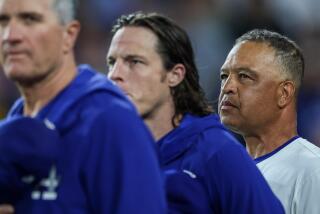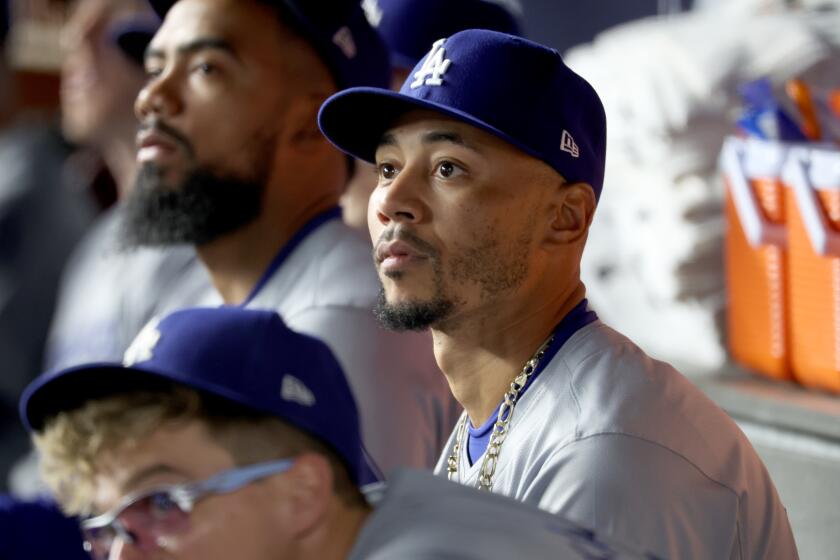Not Your Father’s Dodgers
Set aside for a moment concerns about Frank McCourt’s wallet. The primary architect of the Dodger roster is not the owner of one year but rather the general manager of 11 months, soft-spoken, unassuming Paul DePodesta, who turned all of 32 last month and is looking forward to his only child’s first birthday this month.
Architect is a description the Harvard-educated DePodesta would find flattering because the fictional character he admires most is Howard Roark, the fiercely independent architect in Ayn Rand’s 1943 novel, “The Fountainhead.”
Roark dismissed traditional methods and stood by his radical designs in the face of severe criticism. Rand presented him as a man of extraordinary conviction, and, no surprise here, Gary Cooper played him in the movie.
Fans alarmed at the wholesale shakeup of the Dodgers probably feel DePodesta is more interested in detonating dynamite than in drawing up the blueprint for a winning team. Not that he would be insulted -- Roark too blew things up when he deemed it necessary.
Tradition? Ka-boom! Time-honored methods? Ka-bluwee!
“There are a lot of things we do because that’s the way we’ve always done them, and I do my best to not accept that as an explanation,” DePodesta said. “Circumstances change and you have to be proactive about changing with those circumstances.”
Consider this a seminal moment after 120 years of Dodger history. The man deconstructing and reassembling the roster is doing it one way -- his own. Some of it we’ve heard before: Yes, he values on-base percentage more than batting average. Yes, he believes earned-run average is as much a product of luck as good pitching.
But maybe that’s where “Moneyball” ends and MoneyPaul begins. DePodesta might be more than the latest twig to fall from the Billy Beane-stalk.
He professes to have a grand plan, and if he is implementing it in fits and starts, enraging the New York Yankees one day and Dodger fans the next, at least he is unafraid of implementing it.
“Oftentimes the easy decision and comfortable decision is not the right one,” DePodesta said. “You can come under an awful lot of criticism, especially in such a public role as this one. You have to stick to what you truly believe is right and at the end of the day hopefully you will be rewarded by the team’s performance.”
Sending off a good many architects of last season’s National League West title team -- Adrian Beltre, Shawn Green, Steve Finley, Jose Lima and Alex Cora -- was part of the plan.
DePodesta turned down a proposal from Green two months ago to defer some of next season’s $16-million salary in exchange for an extension because Green, he of the agreeable nature, fan popularity and sporadic power production, was not part of the plan.
DePodesta didn’t return agent Scott Boras’ last-ditch phone call the day Beltre agreed to terms with the Seattle Mariners because Beltre, he of a monstrous 2004 season after six years of inconsistency, was not part of the plan.
DePodesta signed outfielder J.D. Drew and traded for catcher Dioner Navarro because they are central to a plan that also includes other young players acquired in the last year -- Milton Bradley, Jayson Werth, Hee-Seop Choi and Antonio Perez.
The re-signing of Odalis Perez should be the first in a series of moves to shore up the starting rotation.
Fans might not like those deals either.
“We are going to make some moves and make some decisions that aren’t necessarily popular, but we really feel that in the long term this is going to help us,” he said.
The criticism neither surprises nor deters him. If public perception were his primary concern, he says, he wouldn’t have dispatched popular catcher Paul Lo Duca and effective reliever Guillermo Mota to the Florida Marlins at the trading deadline with the Dodgers in first place.
And the team did finish first, marking the eighth time in nine seasons that DePodesta’s employer has made the playoffs.
He was along for the ride as a low-level front-office official with the Cleveland Indians from 1996 to 1998, but Beane handed him increasingly significant responsibility as an assistant general manager with the Oakland Athletics from 1999 to 2003.
“With Paul, what you view superficially is just that -- superficial,” Beane said. “It may not become apparent to you off the bat, but given the time, he can give you at least five reasons why he did what he did for now and the future.
“He’s just brilliant. If everyone’s playing checkers, he’s playing chess. He’s always been one to recognize the present and the future at the same time. He’s got an incredibly creative mind.”
The primary reason DePodesta is making so many changes is that he believes they are long overdue.
“In all honesty, this organization needs a pretty significant overhaul, and has,” he said. “[Former general manager] Dan Evans was in the process of doing it. He understood it needed to be done. But it is a difficult process and not something that can be done overnight.”
The Dodger playoff appearance was their first since 1996 and the team hasn’t been to a World Series since 1988.
“I don’t want to sound like a wise guy, but does the emperor have his clothes?” Beane said. “What’s the tradition?”
A dyed-in-the-blue fan might respond by asking, since when are the small-market Athletics the model for the Dodgers? DePodesta says he recognizes the difference.
“The expectations are diametrically opposed,” he said. “In Oakland we had the opportunity to say we are going to build a dynamic organization but it is going to take a little time. We had a window the first couple of years where nobody expected us to do anything.
“Our challenge this past year was to rebuild and win at the same time. That is a very, very difficult challenge, and, ultimately, that is what we are charged with.
“That’s what we were charged with last year and we came through it incredibly successfully. And that’s what we are charged with again this year.”
Construction is underway. Put on a hard hat and don’t breathe the dust. Whether the finished product is worthy of the effort remains to be seen.
More to Read
Are you a true-blue fan?
Get our Dodgers Dugout newsletter for insights, news and much more.
You may occasionally receive promotional content from the Los Angeles Times.









